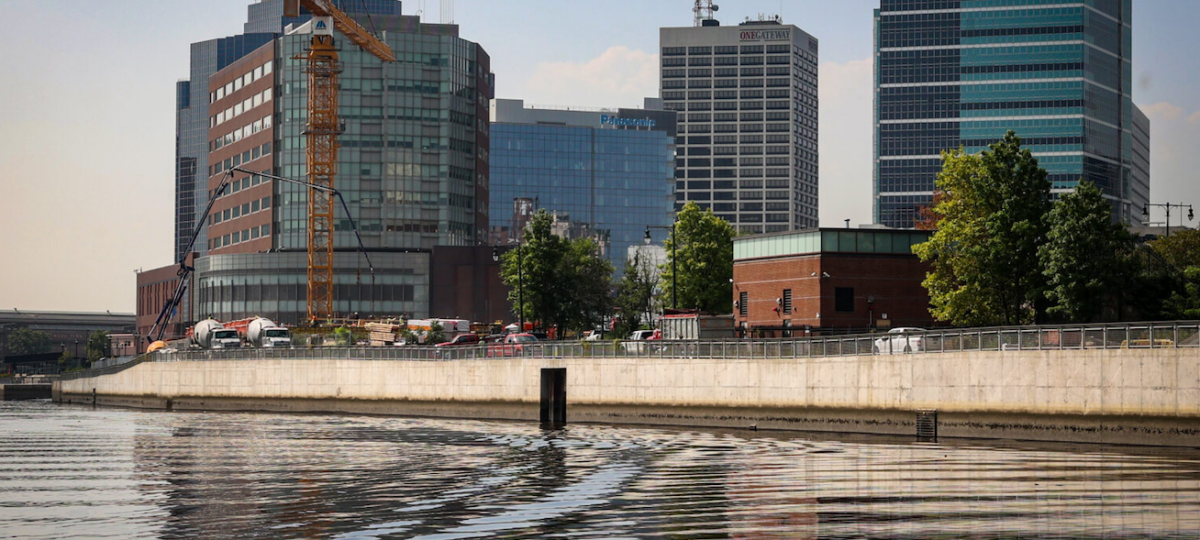Amid Newark building boom, Passaic River flooding poses threat
While the Passaic River has always come through Newark, it is now going to come increasingly higher and heavier. The effects of climate change mean more extreme and unpredictable weather, as well as an inevitably rising tide in coastal and riparian areas such as Newark, the effects of which were seen by the damage done by Hurricane Sandy in 2012 and Tropical Storm Ida in 2021.
According to the New Jersey Climate Change Resource Center at Rutgers University, New Jersey will experience a sea level rise of up to one foot between 2000 and 2030, up to 2 feet by 2050, and up to four feet by 2100. In a scenario where New Jersey does not meet the goals of the Paris Agreement and there is little action to reduce fossil fuel emissions, New Jersey could see sea level rise of over 6 feet by 2100. The result would be that large parts of Newark would be underwater, particularly the already low-lying parts of the Ironbound.
As the water rises and the weather intensifies, one constant fact throughout is climate change will have even greater import: what goes in the Passaic River will come back out into Newark, including the streets and homes of local residents. As the number of homes continues to grow as the pace of redevelopment increases, environmental activist Jeff Tittel warned what the price of extensive building could be.
Residents concerned about new constructions
In the early 1800s, people came to the banks of the Passaic for a range of reasons, such as bathing, drinking, and transport. Then, as the Industrial Revolution took hold, the Passaic’s banks boomed when factories lined the river and business blossomed. This economic growth drew the population that made Newark famous as the state’s largest city, and ultimately created the pollution that made the Passaic infamous, a foul stream of post-industrial toxicity.
Now, the city’s redevelopment is pushing more people to the river’s banks, including in the Ironbound, where the naked eye can’t help but see new construction. Development to the already dense neighborhood of approximately 55,000 people is gathering intensity. New apartment buildings and condos are increasingly dotting the landscape of the largely working-class, immigrant-occupied neighborhood, with construction sites fitting in between the restaurants, bakeries, and two-family homes the closely-knit community is known for. A proposed development on the 2.5 acre site at the former Iberia restaurant framed by Jefferson and Market streets would build two 26-story and two 30-story buildings, creating 1,400 apartments next to the Passaic River.
Local residents expressed concerns about the proposed high-rise project at a recent public meeting at the Sport Club Português. Among those in attendance was Manny Lopes, owner of Lopes & Sons Hardware Inc. on Ferry Street, who is also the president of the Ironbound Business Improvement District.
“When it rains, you don’t have to see much to have water up on the sidewalk. The infrastructure, the sewer, it’s old. And when you get further away from Ferry Street, forget about it. People have to leave their cars in the middle of the water. Flooding is a problem all over the neighborhood,” Lopes said.
There are some significant local efforts to improve stormwater infrastructure. The City of Newark’s Department of Water & Sewer Utilities has rolled out an initiative called RainReady Newark designed to increase the city’s resilience to stormwater.
However, while the city is coming up with a framework to deal with the effects of stormwater on land, officials seemed less certain about how to deal with the stormwater threat coming from the increasingly rising Passaic River, swollen by progressively extreme weather.
“Climate change is real. You’re never going to beat Mother Nature. We’re working with the Army Corps of Engineers right now to put a flood wall up in the East Ward,” said Kareem Adeem, director of the City of Newark’s Department of Water and Sewer Utilities, referencing the city ward that consists mostly of the Ironbound. “The East Ward used to be marshland, and overdevelopment is real.”
“We’ve got to do a better job, and it’s going to take all of us to do it”, Adeem said.


